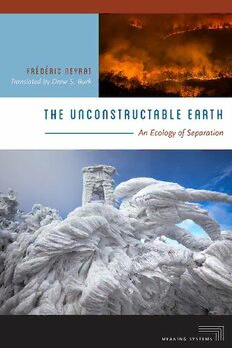
The Unconstructable Earth: An Ecology of Separation PDF
Preview The Unconstructable Earth: An Ecology of Separation
The Unconstructable Earth SerieS editorS Bruce Clarke and Henry Sussman Editorial Board Victoria N. Alexander, Dactyl Foundation for the Arts and Humanities Erich Hörl, Ruhr University Bochum John H. Johnston, Emory University Hans- Georg Moeller, University College Cork John Protevi, Louisiana State University Samuel Weber, Northwestern University T h e U n c o n st r u cta b l e E art h An Ecology of Separation Frédéric Neyrat Translated by Drew S. Burk Fordham University Press: New York 2019 Copyright © 2019 Fordham University Press All rights reserved. No part of this publication may be reproduced, stored in a retrieval system, or transmitted in any form or by any means—electronic, mechanical, photo- copy, recording, or any other—except for brief quotations in printed reviews, without the prior permission of the publisher. This work received the French Voices Award for excellence in publication and translation. French Voices is a program created and funded by the French Embassy in the United States and FACE (French American Cultural Exchange). French Voices logo designed by Serge Bloch. This book was originally published in French as Frédéric Neyrat, La part inconstructible de la terre: Critique du géo- constructivisme, Copyright © Éditions du Seuil, 2016. Cet ouvrage a bénéficié du soutien des Programmes d’aide à la publication de l’Institut Français. This work, published as part of a program of aid for publica- tion, received support from the Institut Français. Fordham University Press gratefully acknowledges finan- cial assistance and support provided for the publication of this book by the University of Wisconsin- Madison. An advance excerpt from Chapter 13 of this book appears in diacritics 45, no. 3 (2017). Fordham University Press has no responsibility for the persistence or accuracy of URLs for external or third- party internet websites referred to in this publication and does not guarantee that any content on such websites is, or will remain, accurate or appropriate. Fordham University Press also publishes its books in a vari- ety of electronic formats. Some content that appears in print may not be available in electronic books. Visit us online at www .fordhampress .com. Library of Congress C ataloging- in- Publication Data avail- able online at https:// catalog .loc .gov. Printed in the United States of America 21 20 19 5 4 3 2 1 First edition for my friends who continue to go on living Contents Introduction: Reconstructing the Earth? .......... 1 Part I. The Mirror of the Anthropocene: Geoengineering, Terraforming, and Earth Stewardship The Copenhagen Chiasm ........................ 25 1. The Screen of Geoengineering ................. 27 2. The Mirror of the Anthropocene ............... 34 3. Terraforming: Reconstructing the Earth, Recreating Life .............................. 45 4. The Logic of Geopower: Power, Management, and Earth Stewardship ........................ 56 Part II. The Future of Eco- constructivism: From Resilience to Accelerationism Turbulence, Resilience, Distance ...................71 5. An Ecology of Resilience: The Political Economy of Turbulence ................................73 6. The Extraplanetary Environment of the Ecomodernists ......................... 83 7. The “Political Ecology” of Bruno Latour: No Environments, No Limits, No Monsters (Not Even Fear) .............................. 90 8. Anaturalism and Its Ghosts ....................105 9. The Technological Fervor of Eco- constructivism ........................118 Part III. An Ecology of Separation: Natured, Naturing, Denaturing Object, Subject, Traject .........................133 10. Naturing Nature and Natured Nature ...........135 11. The Real Nature of an Ecology of Separation .... 146 12. Denaturing Nature ...........................155 13. The Unconstructable Earth ....................165 Conclusion: What Is to Be Unmade? .............179 Notes ..................................... 189 Index ..................................... 225 Introduction Reconstructing the Earth? The combined circumstances that we live on Earth and are able to see the stars—that the conditions necessary for life do not exclude those necessary for vision, or vice versa—is a remarkably improbable one. —Hans Blumenberg, The Genesis of the Copernican World You did not wish to see the face of the Unknown; you will see its mask. —Victor Hugo, Préface de mes œuvres et post- scriptum de ma vie A New Grand Narrative Humanity’s conquest of outer space is over? No. We have simply discovered a new planet: Earth. An Earth we would supposedly be able to reconstruct and pilot thanks to the exploits of an absolute engineering process. Geo- constructivism will be the name bestowed upon this voracious discourse that considers the Earth as the consenting prey of an integral conquest. Aggregat- ing a diverse number of philosophical, economic, and scientific lines of inquiry, geo- constructivism asserts itself at the intersection of several discourses: the discourses of engineers and architects who would like to transform the Earth into a pilotable machine; biologists who would rather spend their time resur- recting already extinct species rather than protecting those that are still alive; political strategists offering solutions for global governance; the advent of new markets by businessmen who view climate change as a new industry for eco- nomic speculation; geographers enthralled by the power of humanity within the age of the Anthropocene; sociologists and anthropologists proclaiming that there is no common world and so it is up to us to build one; essayists promoting nuclear energy for all; prophets declaring the death of nature or the birth of the transhuman; philosophers inviting us to accelerate our technological control
